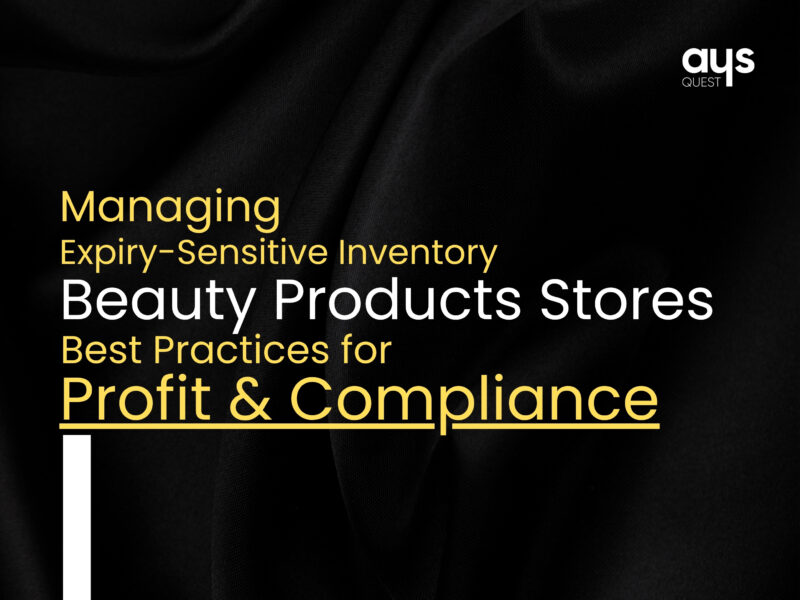Inventory management is vital in any retail business, but in beauty and cosmetics, it requires extra attention due to the short shelf life of many products. From skincare creams and serums to makeup and hair care items, most beauty products come with expiry dates that, if ignored, can lead to financial loss, regulatory issues, and damage to brand reputation.
In this blog, we explore best practices for managing expiry-sensitive inventory in beauty product stores to minimize waste, enhance customer satisfaction, and ensure compliance with health and safety standards.
1. Understand Shelf Life of Beauty Products
The first step in managing expiry-sensitive inventory is to categorize products by their shelf life. For example:
- Skincare products (lotions, creams): 6 to 24 months
- Makeup (foundation, mascara, lipstick): 6 to 18 months
- Fragrances and perfumes: 2 to 5 years
- Hair care products: 12 to 24 months
Understanding the expiration cycle helps retailers plan promotions and sales to clear out stock before it becomes unsellable.
2. Use FIFO & FEFO Inventory Methods
Implement inventory rotation methods such as:
- FIFO (First In, First Out): Older stock is sold before newer stock.
- FEFO (First Expired, First Out): Products with the earliest expiration dates are sold first, regardless of arrival time.
These methods are especially crucial for high-volume or fast-moving inventory, helping to avoid stock obsolescence.
3. Digital Inventory Tracking Systems
Manual inventory management is prone to human error. Invest in inventory management software that can:
- Track expiry dates for each batch or lot
- Generate automatic alerts for upcoming product expirations
- Provide real-time stock visibility
- Enable barcode or QR code scanning for quick updates
Popular tools include Zoho Inventory, NetSuite, or Shopify plugins tailored for beauty retailers.
4. Monitor Stock Levels Regularly
Conduct regular inventory audits to check for:
- Products nearing expiry
- Damaged or contaminated stock
- Overstock or understock issues
Maintaining optimal stock levels ensures you don’t hold on to expired products or run out of fast-moving items.
5. Educate Staff on Expiry-Sensitive Products
Train store employees to:
- Identify and check expiry dates
- Rotate stock appropriately during restocking
- Handle products with care to extend shelf life
Staff awareness plays a major role in reducing loss from expired goods and maintaining a healthy retail environment.
6. Offer Discounts on Soon-to-Expire Stock
Avoid complete loss by promoting nearing-expiry products at a discounted rate. Highlight these offers:
- In-store bins labeled “Special Deals” or “Limited Time Offers”
- Online store banners
- Email campaigns to loyal customers
This helps you recover costs while giving customers an incentive to try new products.
7. Optimize Storage Conditions
Improper storage can accelerate product degradation. Maintain proper temperature, humidity, and light exposure for all beauty products:
- Use cool, dry storage spaces
- Keep products away from direct sunlight
- Seal products properly to avoid air contamination
Storage optimization helps extend shelf life, even for organic or preservative-free beauty items.
8. Collaborate With Suppliers
Build relationships with suppliers who offer:
- Transparent batch tracking
- Clear expiration date labeling
- Flexible return or exchange policies for expired stock
Some suppliers also offer consignment models, reducing your risk of holding unsellable inventory.
9. Analyze Sales Data to Forecast Demand
Review historical data to:
- Predict seasonal demand (e.g., sunscreen in summer, makeup during holidays)
- Adjust purchasing schedules
- Prevent overstocking of slow-moving products
Using tools like Google Analytics, POS systems, or CRM software, you can optimize inventory levels based on actual buying trends.
10. Stay Compliant With Regulatory Standards
Expired products can lead to legal penalties and customer complaints. Make sure your store:
- Never sells expired goods
- Keeps accurate inventory records
- Complies with FDA, EU, or regional cosmetic regulations
Clearly label products with manufacture and expiry dates for transparency.
Final Thoughts
Managing expiry-sensitive inventory in beauty product stores is not just about reducing waste—it’s about protecting your brand, ensuring customer safety, and maintaining a profitable operation. By leveraging smart tracking tools, training staff, and optimizing storage and sales strategies, you can turn potential losses into opportunities for growth and loyalty.





